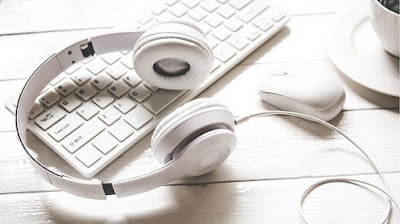Chapter Report Unit 7 :: AUDIO
Hearing and Listening
Hearing is a process in which sound waves entering the outer ear are transmitted to the eardrum, converted into mechanical vibrations in the middle ear, and changed in the inner ear into electrical impulses that travel to the brain. While listening begins with someone's awareness of and attention to sounds or speech patterns (receiving), proceeds through identification and recognition of specific auditory signals (decoding), and ends in comprehension (understanding).
Transmission and reception might be inhibited by a number of obstacles. First, the volume of the sound might be too low or too high. Second, a sound that is sustained monotonously, such as the droning voice of a teacher, may trigger auditory fatigue. Third, an individual's ability to hear may be physically impaired. when students have a cold, it is possible that their ability to hear in a noisy classroom is reduced.
Developing Listening Skills
Hearing is the foundation of listening. Therefore, you should first determine whether all of your students can hear normally. You can use a number of techniques to improve student listening abilities:
1. Guide listening. Start with short passages and one or two objectives, then gradually length the passage and the number complexity of the objectives or questions.
2. Give directions. Give students directions individually or as a group on audiotape.
3. Ask students to listen for main ideas, details, or inferences. Use this technique when you want students to draw details and inferences from the passage.
4. Use context in listening by listening to sentences with words missing and then supplying the appropriate words.
5. Analyze the structure of a presentation. You can determine how well they were able to discern the main ideas and to identify the subtopics.
6. Distinguish between relevant and irrelevant information. Ask students to identify the main idea and then rate (from most to least relevant) all other presented ideas.
Audio Formats
Let's examine the comparative strengths and limitations of the audio formats most often used for instructional purposes:
Audiotape, the major advantages of audiotape are that you can record your own tape easily and economically, and when the content becomes outdated or no longer useful, you can erase the magnetic signal on the tape and reuse it. Tapes are not easily damaged, and they store easily. Unlike discs, broken tapes can be repaired, although not easily.
Compact Discs, the technology of the CD makes it an attractive addition to education programs. Users can quickly locate selections on the disc and it can program them to play in during quality sound reproduction. The equipment to create, or "burn", CD-ROM and CD audio disc has become very affordable for the average audiophile, which makes it easy for an individual to prepare CDs that contain "favourite" music on them. Copyright needs to be checked when doing this.
MP3 is a way for audiophiles to enjoy their favourite music. It is also a way to obtain the newest versions of a particular artist's song. Some internet sites let users customize their selections so they can create unique "albums". On the downside, a word of caution related to copyright: Not all internet sites make legal copies of music available. It is the responsibility of the user to respect the copyright laws related to audio.
Producing Class Materials on Cassette Tapes
Students can use cassette tapes for gathering oral histories and preparing oral book reports. The teacher can prepare tapes for use in direct instruction, as illustrated by the vocational-technical school. The cassette recorder can be used for presenting book reports during study time in the media centre or at home. You can evaluate the reports and keep the best ones on file in the media centre. Tape recorders can be used to record information gleaned from a field trip. On returning to the classroom, students can playback the tape for discussion and review. Students can also record themselves reciting, presenting a speech, performing music, and so on.
Duplicating and Editing Audiotapes
It is a relatively simple procedure to duplicate an audiotape. You can duplicate your tapes by one of three methods: the acoustic method, the electronic method, and the high-speed duplicator method. The acoustic method does not require any special equipment, just two recorders. One recorder plays the original tape and the sound is transferred via a microphone to a blank tape on the other recorder. The electronic method avoids this problem. The signal travels from the original tape to the recorder via an inexpensive patch cord. The high-speed duplicator method requires a special machine.
Selecting Audio Materials
In selecting audio materials to use in your instruction, first determine what materials are available locally. Consult with a media specialist to determine what is available in your media centre. If appropriate materials are not available, refer to the appropriate directories.
Utilizing Audio Materials
The next step after selecting or producing your audio materials is to use them with your students. The five PS are appropriate for group use of audio materials:
1. Preview the materials
2. Prepare the materials
3. Prepare the environment
4. Prepare the learner
5. Provide the learning experience
Require Learner Participation
Before you begin the lesson, determine how to get and keep your students actively involved. One technique is to give students a set of questions to answer during the listening. Younger learners may act out the role portrayed in the materials. Foreign language tapes may include pauses for learners to practice pronunciation. After listening to a story they may draw a scene from the audio description.
Evaluate and Revise
Determine how effective the audio materials were. You can gather data by making observations, evaluating test results, or discussing the experience with students. You may decide to revise how you use the materials or to modify the materials themselves.

Komentar
Posting Komentar